The Western Digital Black PCIe SSD (512GB) Review
by Billy Tallis on March 8, 2017 8:30 AM ESTMixed Random Read/Write Performance
The mixed random I/O benchmark starts with a pure read test and gradually increases the proportion of writes, finishing with pure writes. The queue depth is 3 for the entire test and each subtest lasts for 3 minutes, for a total test duration of 18 minutes. As with the pure random write test, this test is restricted to a 16GB span of the drive, which is empty save for the 16GB test file.
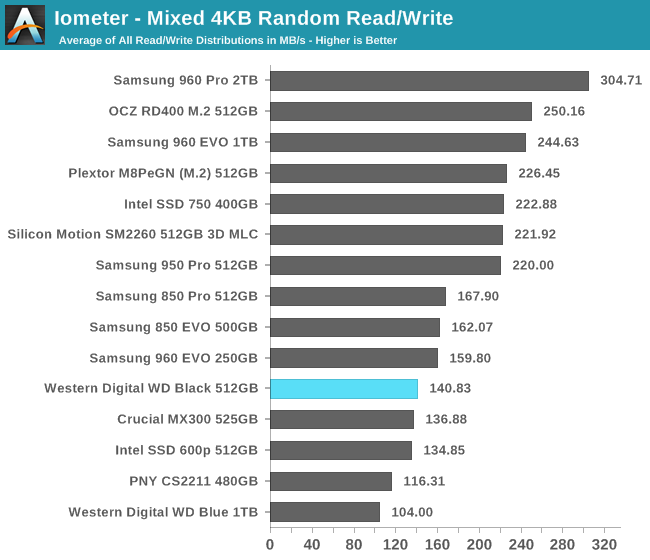
The WD Black's mixed random performance is better than most SATA SSDs and better than the Intel 600p, but both the Samsung 850 EVO and 850 PRO have a clear advantage over the WD Black.
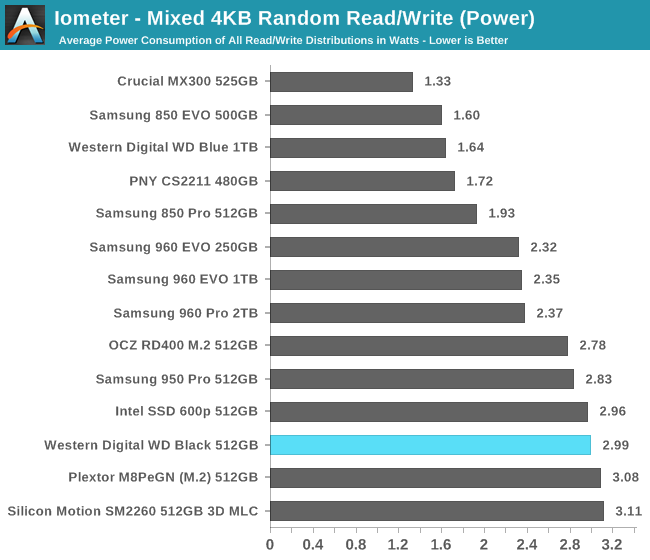
The WD Black's power consumption is a bit high by PCIe standards, but not quite as high as the Plextor M8Pe which uses the same controller. Given the sub-par performance of the WD Black, its efficiency is bad: on par with the Intel 600p, less than half that of the Samsung 850 EVO or Crucial MX300, and far behind that of the Samsung 960 EVO.
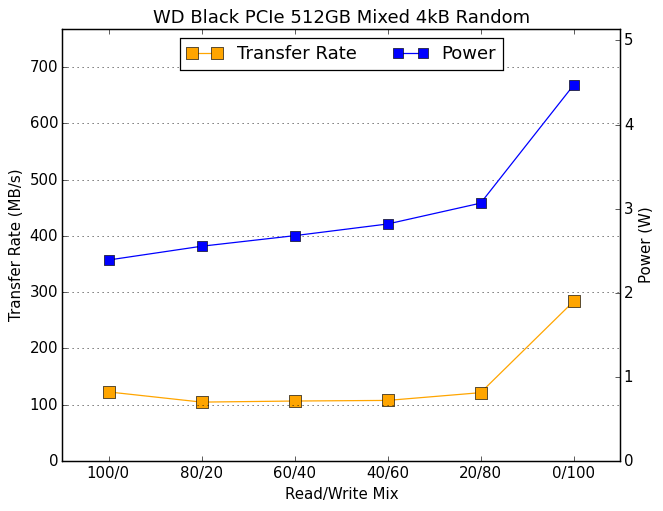 |
|||||||||
The WD Black's performance is pretty flat over the course of the mixed random I/O test, save for the typical jump in the final phase as the workload shifts to pure random writes. The jump isn't high enough to bring the average up above the best SATA SSDs, and the WD Black doesn't show the gradual improvement over the course of the test that the MLC PCIe SSDs experience.
Mixed Sequential Read/Write Performance
The mixed sequential access test covers the entire span of the drive and uses a queue depth of one. It starts with a pure read test and gradually increases the proportion of writes, finishing with pure writes. Each subtest lasts for 3 minutes, for a total test duration of 18 minutes. The drive is filled before the test starts.
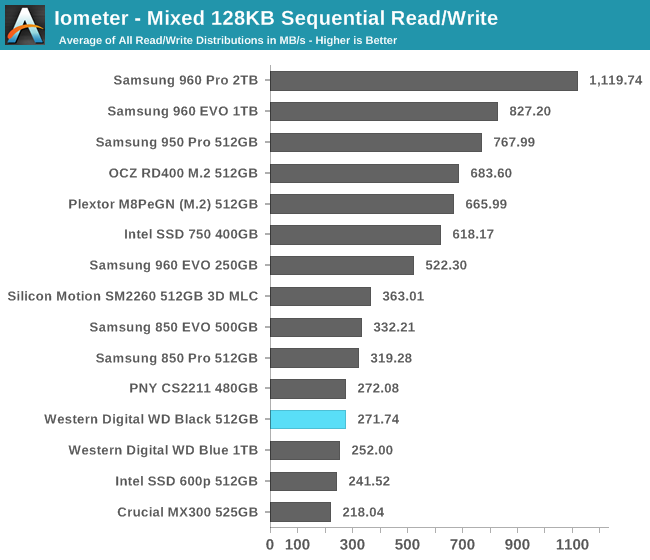
On the mixed sequential I/O test the WD Black performs like a good but not great SATA SSD, with a slight advantage over the WD Blue.
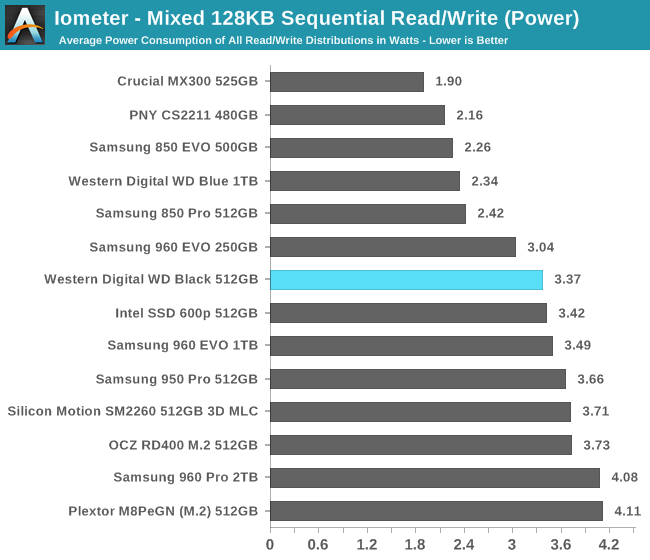
The WD Black's power consumption during this test is on the low side of normal for PCIe SSDs, but its efficiency still isn't remotely competitive with Samsung's 3D TLC.
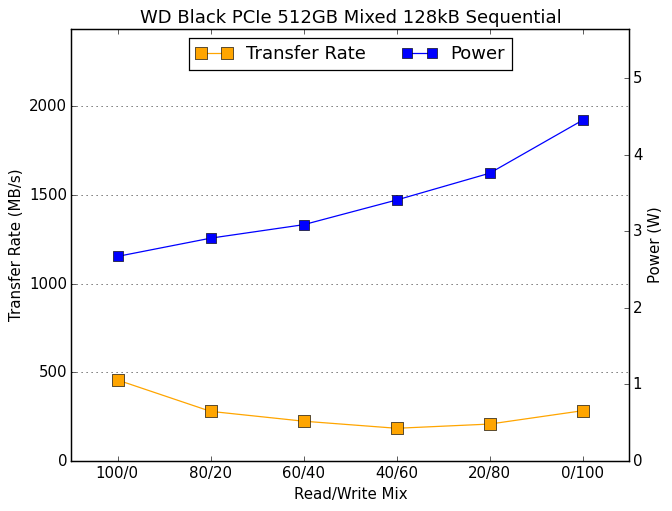 |
|||||||||
The WD Black starts the test with performance near the limit for SATA, but it drops from there as writes are added to the mix. The performance recovers slightly in the final two phases of the test. Power consumption climbs steadily over the course of the test, while most drives manage to reduce power consumption slightly as their performance drops.










36 Comments
View All Comments
dgingeri - Wednesday, March 8, 2017 - link
At least they priced it about right. It's more expensive than the Intel 600p, but far less expensive than the 960 EVO and slightly less expensive than the M8Pe. This part of the market is odd. Usually, the fastest performing parts are FAR more expensive for just a small return on performance. In SSDs right now, the differences in price are fairly small, but the differences in performance are huge. I think the 960 EVO is about the best deal for a SSD, and this thing is just a shame to the "Black" label.Guspaz - Wednesday, March 8, 2017 - link
So, the product called "WD Black" is coloured blue, but there is also a "WD Blue" product? Let me guess, that one has a black PCB?Gasaraki88 - Wednesday, March 8, 2017 - link
Nope, it would have made sense if they spent the money to use a black pcb for the black drive, a blue pcb for the blue drive and the green pcb for the green drive. Nope.This drive gives the "Black" label a bad name anyway.
MrSpadge - Wednesday, March 8, 2017 - link
They probably thought "our Black HDDs are really slow nowadays, with all those budget SSDs around, so let's call a barely-not-too-slow SSD: BLACK".madspartus - Wednesday, March 8, 2017 - link
WD Black: planar 15 nm TLC NANDI'll be sure to remember that WD doesn't give a shit about the quality and performance of their products and branding. Way to dilute the brand, hope the short term gains are worth it.
shabby - Wednesday, March 8, 2017 - link
The branding is fine, the wd green ssd will be a qlc nand drive.bug77 - Thursday, March 9, 2017 - link
True, black has always been the performance line, it shouldn't go on any TLC parts. Not even on 3D TLC.romrunning - Wednesday, March 8, 2017 - link
On your Storage Bench - Light (Latency) graph, you show the Intel 750 and Patriot Hellfire on top despite the Samsung drives beating them both in "Full" condition. So if they tie on the empty drive score, the Samsungs should be on top due to their full drive latency.Gasaraki88 - Wednesday, March 8, 2017 - link
How come you didn't test any drives that use the Phison E7 controllers? Patriot Hellfire, MyDigitalSSD BPX, and Corsair Force?BrokenCrayons - Wednesday, March 8, 2017 - link
This certainly isn't an impressive product.